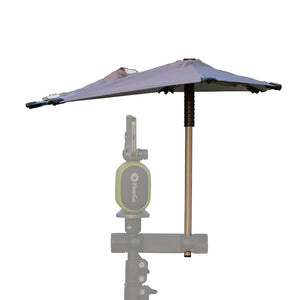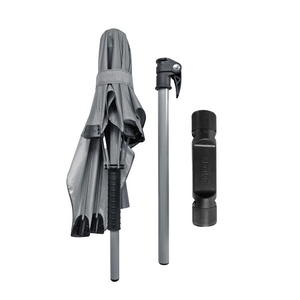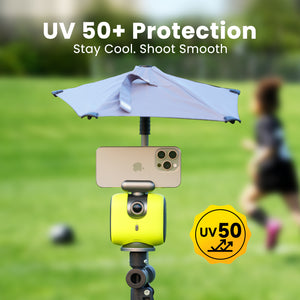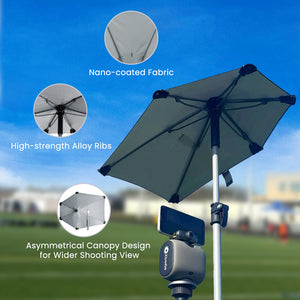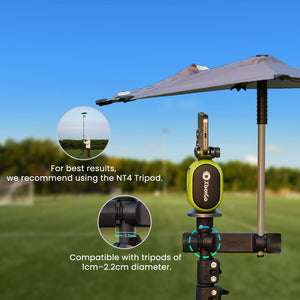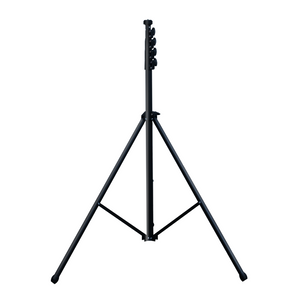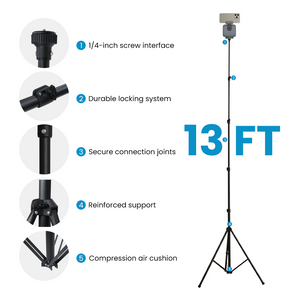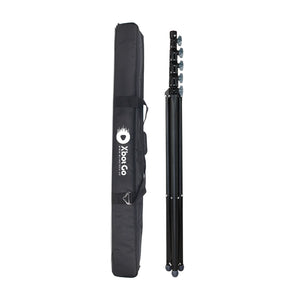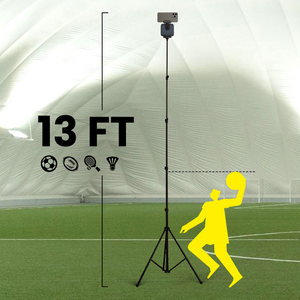XbotGo Chameleon AI Sports Camera
Hockey Skate Profiling Guide: Unlock Your Ice Performance
Ever wonder why your skating feels "off" even with brand new skates? Here's something that might blow your mind: Coach Jeremy from Hockey Tutorial didn't think skate profiling would make much difference—until he tested it himself. "I didn't think I would notice the difference that much but definitely do," he admitted after switching between profiles. If you're ready to unlock your skating potential, you're in the right place.
Understanding Hockey Skate Profiling
What is Skate Profiling?
Think of your skate blade like a section of a giant circle. If you could continue that curve all the way around, you'd have a complete circle measured in feet. That's your blade profile—and it's probably not optimized for you right out of the box.
Skate profiling is the process of reshaping your blade's curve from heel to toe. This isn't the same as sharpening (which creates your edges). Profiling changes how much blade touches the ice and where, directly affecting your speed, agility, and balance.
Here's the kicker: factory skates almost never come properly balanced.One player discovered their new skates had "15mm in front of the center line and 10mm behind on one runner, while the other runner had 10mm in front and 15mm behind." That imbalance? It's been holding you back.
The Four Zones of Your Blade
Your blade isn't just one continuous piece of metal—it's actually four distinct performance zones:
Acceleration Zone (Toes): This front section powers your first three strides from a standstill. A more curved profile here means quicker starts but less stability.
Transition Zone (Ball of foot): Your agility headquarters. This zone handles direction changes, pivots, and those explosive moves out of tight turns.
Speed Zone (Arch to heel): The largest zone, engineered for top-end speed. More blade contact here means better glide and less effort maintaining speed.
Stability Zone (Heel): Your balance foundation. This zone keeps you stable whether you're flying down ice or battling in the corners.
Why Factory Skates Need Profiling
Here's what manufacturers don't tell you: those shiny new skates aren't customized for your body mechanics. They're stamped with a generic 10- or 11-foot radius that works "okay" for everyone but great for no one.
Professional equipment managers check every pair because they know the truth. As one person put it, "Everyone should get their runners profiled because they almost never come balanced from the factory."
Even if your skates started balanced, repeated sharpenings gradually change your profile. After 10 years of sharpening, one player realized, "I'd imagine the profile can get out of whack after a while just from repeated sharpening."
Profile Types and Performance Impact
Single vs Multi-Radius Profiles
Single Radius Profiles are old school—one continuous curve from heel to toe. Simple, but you're forced to choose: want agility? Go with a 7-foot radius but sacrifice speed. Want speed? Choose 13-foot but kiss your quick turns goodbye.
Multi-Radius Profiles changed the game. By combining different curves on one blade, you can have it all:
- Dual profiles: Two curves for balanced performance
- Triple profiles: Three zones optimized for specific moves
- Quad profiles: Four distinct radii for maximum customization
Coach Jeremy tested these differences firsthand. On 13-foot profiles, he noted: "Feels like a touring skate, you can just sort of glide... you do notice the extra toe and heel there."
Heel Glide vs Center Glide Systems
This is where profiling gets interesting. There are two schools of thought:
Heel Glide Profiles start rockered (curved) at the toe and flatten toward the heel. Think of them as front-wheel drive for your skates—agile up front, stable in back. Most performance profiles today (Quad, Triple, Zuperior) use this approach.
Center Glide Profiles create a flat spot under your foot's center, with curves at both ends. Originally from speed skating, these profiles (like the SCS series) are "popular with pro players across North America" according to Elite Performance Tech.
Performance Metrics by Profile Type
Ice Warehouse's testing revealed measurable differences using a 1-10 scale:
|
Profile |
Acceleration |
Agility |
Speed |
Stability |
Overall |
|
Stock 10' |
4/10 |
5/10 |
4/10 |
4/10 |
4.25/10 |
|
Triple.1 |
6/10 |
5/10 |
8/10 |
8/10 |
6.75/10 |
|
Polaris |
5/10 |
7/10 |
9/10 |
9/10 |
7.5/10 |
|
SCS.1 |
8/10 |
10/10 |
8/10 |
6/10 |
8.0/10 |
The numbers don't lie—proper profiling nearly doubles your performance metrics.
Choosing Your First Profile
Position-Based Recommendations
Different positions demand different profiles. Here's what actually works:
Forwards:
- Dual or Triple radius profiles boost speed while maintaining agility
- Popular choice: 9-foot or Zuperior profiles
- Focus: Quick acceleration and tight turns
Defensemen:
- Single radius (11-13 foot) or Quad profiles for stability
- Popular choice: Quad.1 or 11-foot single
- Focus: Backward skating and positioning
Goalies:
- Custom lower radius profiles (27-30 foot)
- Specific options: GOALIE SAM for agility, GOALIE ELLIPSE for stability
- Focus: Lateral movement and butterfly slides
What Pro Players Actually Use
Real NHL players optimize their profiles:
- Connor McDavid: Custom triple-radius for explosive speed
- Sidney Crosby: Quad profile balancing agility with sharp cuts
- Auston Matthews: Dual-radius for acceleration and shooting power
- Victor Hedman: Single-radius maximizing defensive stability
The Reality of First-Time Selection
Let's be honest—picking your first profile is tough. As one bluntly stated: "You don't. It's a crapshoot. This is the problem with profiling; too many options and no way to test them out without ruining your steel."
But here's practical advice from the community:
- Start simple with a combination (dual) profile
- Work with knowledgeable shop technicians
- Expect 2-3 adjustments before finding your sweet spot
- Don't change both profile and hollow at once
One defenseman shared: "I had to get mine profiled 3 times until we found the sweet spot." That's normal—embrace the process.
Professional Profiling Process
ProSharp vs CAG Systems
Not all profiling machines are equal. Understanding the difference helps you choose the right shop:
ProSharp System:
- Shapes 70% of your blade
- Uses radius curves throughout
- Creates smooth transitions
- Most common in pro shops
CAG System:
- Adds a flat spot at blade center
- Based on speed skating technology
- Used by many NHL teams
- Less common but highly effective
Balance Point Measurement
Glen from Sharpley Source for Sports revealed the professional technique: equipment managers use a 60/40 split measurement system. "More of our foot is more forward than back... I'm just setting up your optimum balance point."
This precision matters. The balance point determines how you naturally position over your skates, affecting everything from stride power to edge control.
When Hand-Cutting Won't Work
Coach Jeremy learned this watching the pros: "There's no possible way to do this and hand cut a radius. As much as somebody thinks they might be able to get close, you'd be shocked when you re-do somebody's how out you would be."
The specialized jigs and templates required for accurate profiling make DIY attempts futile. Even experienced sharpeners need proper equipment to maintain profile integrity.
Getting Your Skates Profiled
Finding Quality Service Providers
Not every shop can handle profiling properly. Look for:
- ProSharp or Elite certification
- CAG machine availability
- Experienced technicians who ask about your skating style
- Shops that offer profile adjustments
Pro tip from community: "Most hockey shops will let you bring your skates back in to adjust the profile if the first one isn't right. They want your business."
Mail-In Options for Remote Areas
Living in North Florida or another hockey desert? The community consistently recommend:
SkateTech Skate Sharpening
- Run by Chad, former St. Louis Blues equipment manager
- Mail-in service with professional results
- Trusted even by players in hockey hotbeds
No Icing Sports
- Comprehensive profiling options
- Detailed consultation process
- Ships nationwide
One user testified: "I live in what people would consider a hockey hotbed... and I still send my steel to SkateTech to be profiled."
What to Expect: The Adjustment Process
Your first time on newly profiled skates might feel weird. One player switching to a triple profile admitted: "I have fallen twice that I blamed on the change, once off the shorter toes and once doing a backward pivot drill."
Expect:
- 3-5 sessions to fully adjust
- Initial awkwardness in familiar movements
- Gradual realization of improved performance
- Possible need for hollow adjustment
Maximizing Your Profile Performance
Advanced Performance Analysis
Modern technology takes profiling benefits to the next level. Smart coaches and players now use AI-powered sports cameras like XbotGo Chameleon to analyze skating mechanics before and after profiling.
The footage reveals stride efficiency improvements, edge angle optimization, and acceleration gains that might otherwise go unnoticed.
By comparing your skating footage with different profiles, you can objectively measure which setup maximizes your speed, agility, and overall performance—taking the guesswork out of profile selection.
Maintenance and Re-Profiling Schedule
Your profile isn't permanent. Industry experts recommend:
- Profile check: Every 3-4 months
- Full re-profile: Start of season, mid-season, before playoffs
- New steel: Always profile before first use
- After 20+ sharpenings: Consider re-profiling
Regular sharpening gradually alters your profile, especially with hand sharpening. Automated systems like ProSharp maintain profiles better during routine maintenance.
Take Action on Your Skating Performance
Skate profiling isn't just for pros—it's for anyone who wants to maximize their ice time. Whether you're chasing your beer league championship or helping your kid improve, proper profiling makes a measurable difference.
Find a qualified shop or mail-in service, tell them your position and skating style, and be patient with the process. Remember Coach Jeremy's surprise at the difference profiling made? That could be you after your next session.
Ready to stop fighting your skates? Get them profiled and feel the difference.
XbotGo Chameleon AI Sports Camera
Capture every moment with AI-powered tracking. Perfect for coaches, parents, and athletes who want seamless footage without manual filming.







 Soccer
Soccer Basketball
Basketball Ice Hockey
Ice Hockey Rugby
Rugby










